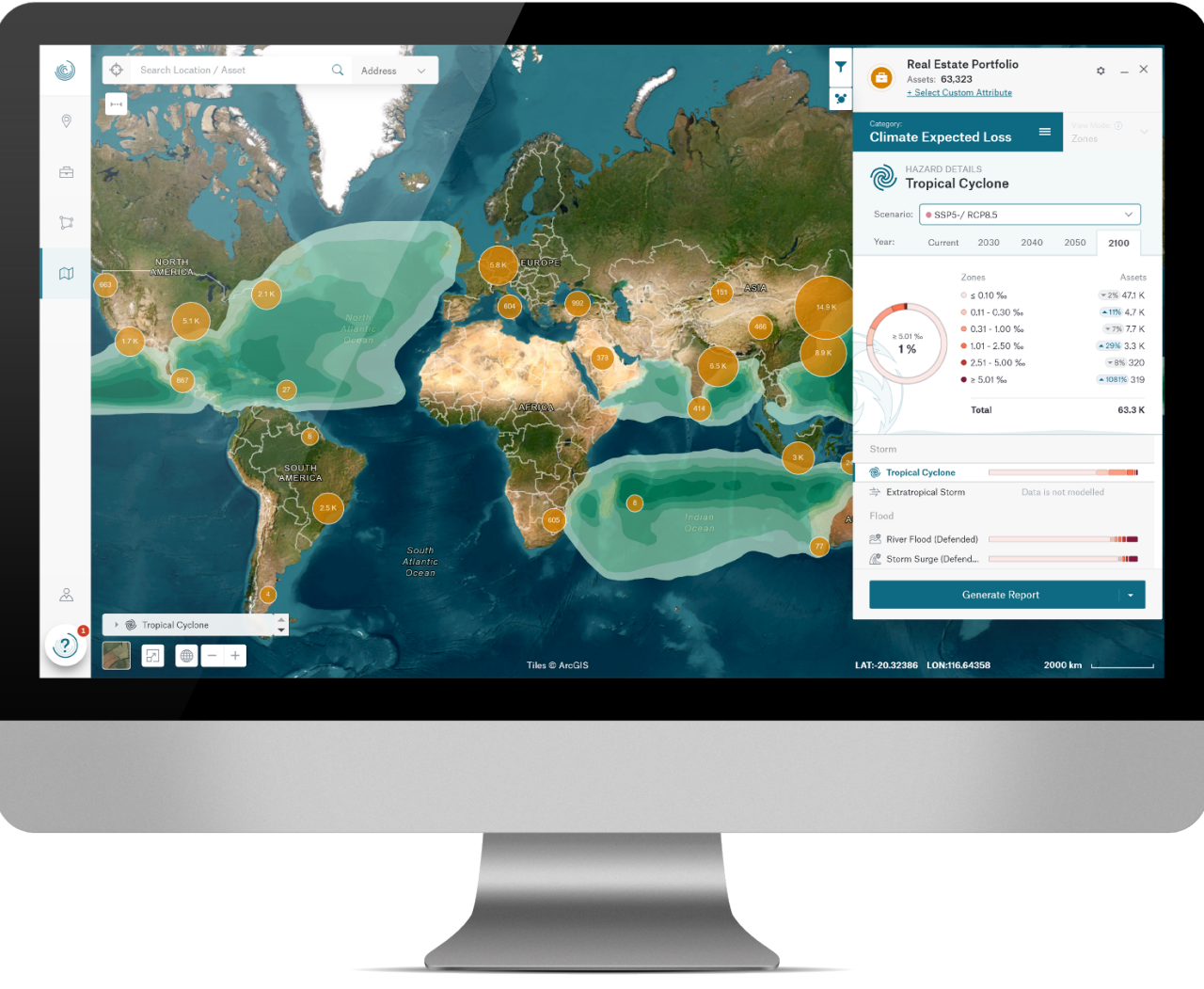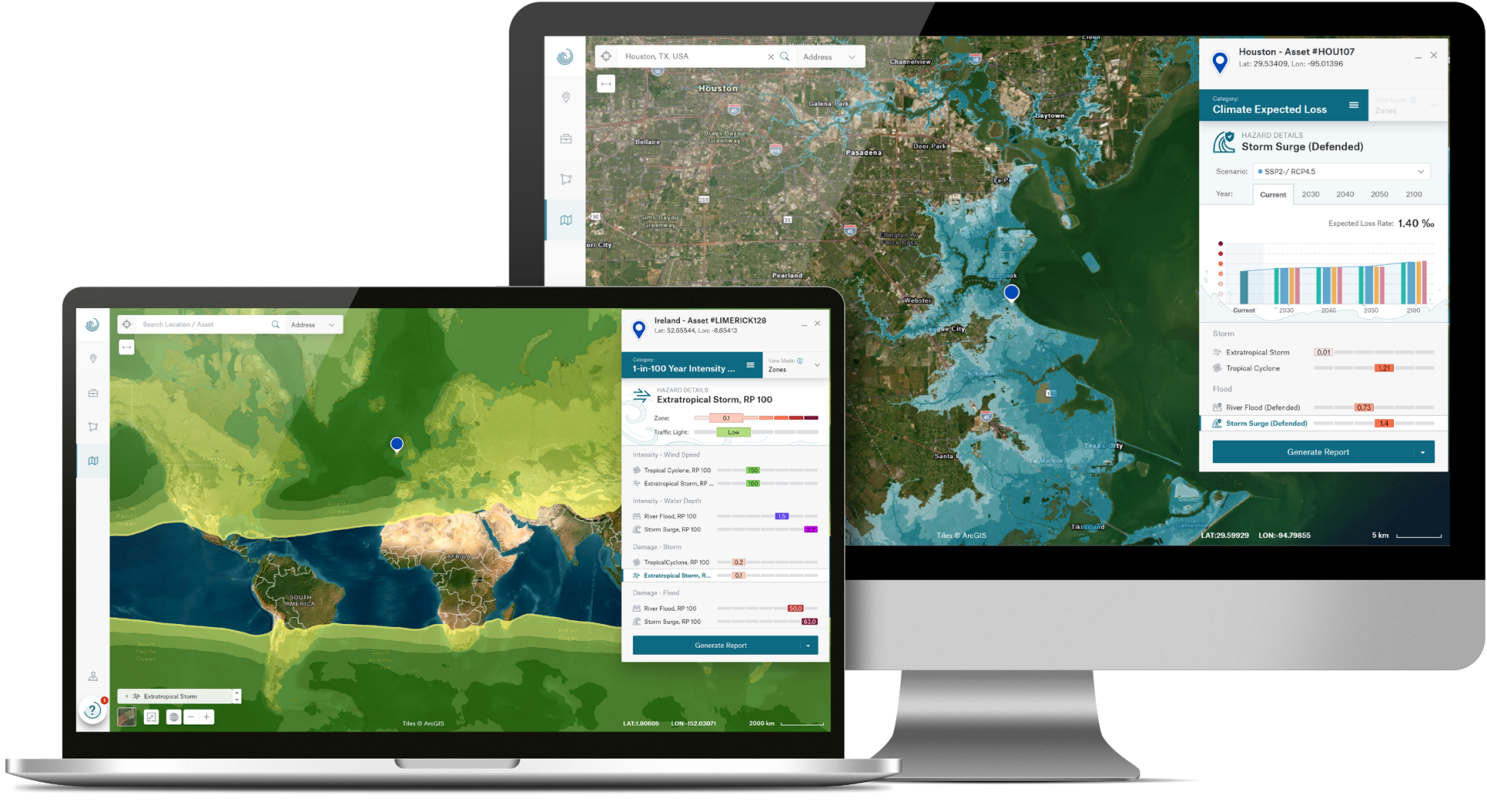
Munich Re’s
Climate Financial Impact Edition
Climate change has serious impacts - financial ones too. Better be prepared
properties.trackTitle
properties.trackSubtitle
Be prepared for the financial impact of climate change. Make sure you can not only assess and understand natural disaster risks such as hurricanes, extratropical storms, floods, storm surges etc. up to the year 2100 by using different climate change scenarios representing the impacts of global warming. And also find out what this could cost you.
In 2024 natural hazards caused a total global loss of around US$ 320 billion.* What is striking is that rising temperatures can result in more frequent and intense weather events, leading to higher losses. 139 natural disaster events caused damage of more than 100 million US$ each*.
Success is not a matter of chance, but the sum total of the right decisions.
Climate change has once again fundamentally altered the influencing factors. To make the right decisions under these new conditions, you need to be able to reliably assess not only how climate risks could affect your investments or assets, but also to what financial extent.
With Climate Financial Impact Edition you can integrate your exposure to these risks into your financial projections, based on solid financial metrics from the world’s largest reinsurer*, and obtain a detailed assessment of the direct financial impact on your operational, market and credit risks. Using a variety of metrics, you can analyse opportunities and risks from different perspectives to identify the most vulnerable assets and make adjustments to improve your portfolio’s resilience to climate risks.
*Source: Largest Global Reinsurance Groups in the World 2024, beinsure.com
How to anticipate and avoid financial losses from climate risks with Climate Financial Impact Edition
Benefit from the integration of climate-related financial risk data into your business processes and decisions.
- Stay ahead of the game: Financial figures indicating the expected losses from various climate risks allow you to measure the risks posed by natural disasters and climate change in monetary terms and to assess them in advance.
- Reduce the risk of revenue losses and reputational damage: Identify potential risks from climate change before they impact on your assets and portfolios to proactively steer your investments towards more profitable and secure returns – now and in the future.
- Keep an eye on the future of your business: With Climate Financial Impact Edition you can not only protect your business by anticipating the potential financial impact of natural disasters on your business, but also assess how markets are changing and where new opportunities are emerging for your company.
- Act before financial damage materialises: Thanks to Climate Financial Impact Edition, you can easily identify areas of high risk concentration and assess the financial impact of the expected damage to your investments and mitigate risks before they materialise.
- Invest safely: Check the risks relating to individual assets or entire portfolios using Munich Re’s set of global warming scenarios, looking up to 80 years into the future.
- Demonstrate outstanding performance: Prove your commitment to the success of your business by improving your performance and results (e.g. profitability, loss ratio / probability of default) through sound data analysis.
- Become attractive for investors and clients: Thanks to your improved ESG and risk strategy, you will boost confidence in your business and your company.
Financial impact metrics you can rely on
Secure your company's financial future with three key metrics. Climate Expected Loss, which allows you to quantify the expected annual loss from physical property damage. 1-in-100 Year Damage, which indicates the expected level of damage to an affected asset in a 1-in-100 year event. And 1-in-100 Year Hazard Intensities, which reflect the hazard intensity in a 1-in-100 year event.

Climate Expected Loss
Climate Expected Loss (CEL) is the average annual expected loss per year due to physical damage to buildings and their contents due to specific weather-related natural hazard events. It allows you to understand the expected asset value deterioration per year, to make informed decisions on whether and what kind of risk transfer is required, and to determine if specific investments make sense from a financial perspective.
Calculating Climate Expected Loss (example: River Flood)
Hazard intensity and building vulnerability form the basis for the calculated expected loss.
1-in-100 Year Damage
The 1-in-100 Year Damage metric measures the damage degree to an affected asset at a location-specific hazard intensity with a return period of 100 years. This metric indicates the extent of damage to the asset, expressed as a percentage of its value, ranging from 0% to 100% (representing none to total destruction).
1-in-100 Year Hazard Intensities
1-in-100 Year Hazard Intensities provide quantifiable measures of the intensity of events with a return period of 100 years, such as flood inundation depths and peak wind speeds.

With the comprehensive financial indicators in Climate Financial Impact Edition, our clients can now also quantify the potential financial impact of climate change on their investments and assets, based on climate-related expected loss values, and take appropriate countermeasures in a timely manner according to their risk appetite.
Industries that benefit in particular
Insurance
Banking and financial services
Real estate
Manufacturing companies
Service providers
For further information simply download our “Climate Financial Impact Edition” brochure!





